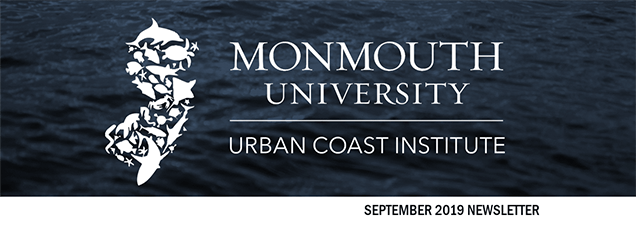
The 15th Annual Future of the Ocean Symposium and Champion of the Ocean Awards Luncheon
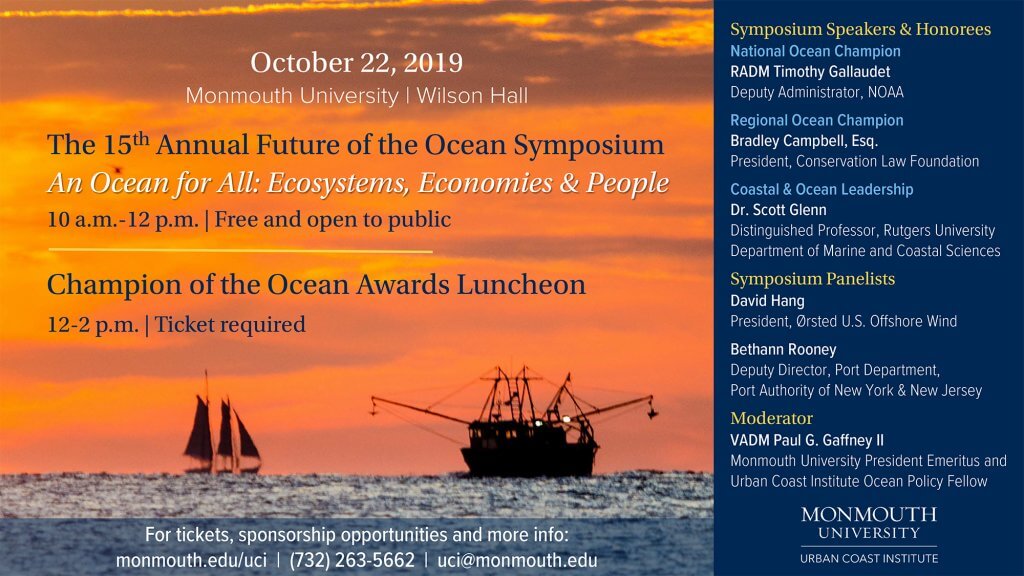
The UCI will host its 15th Annual Future of the Ocean Symposium and Champion of the Ocean Awards Luncheon on Oct. 22 at the historic Great Hall at Shadow Lawn. With a theme of “An Ocean for All: Ecosystems, Economies & People,” the symposium will assemble nationally recognized experts to share insights on the research, science and technology priorities necessary to ensure our oceans continue to thrive ecologically while serving an expanding cross-section of users. Visit our event web page for registration and more information.
Monmouth Polling Institute, UCI to Host Marine Plastics Panel Oct. 2 at 6 p.m.
The Monmouth University Polling Institute and UCI will co-host a panel discussion on the issue of marine plastics on campus Oct. 2 at the Lauren K. Woods Theatre. The event is free and open to the public. Access directions to campus and the venue.
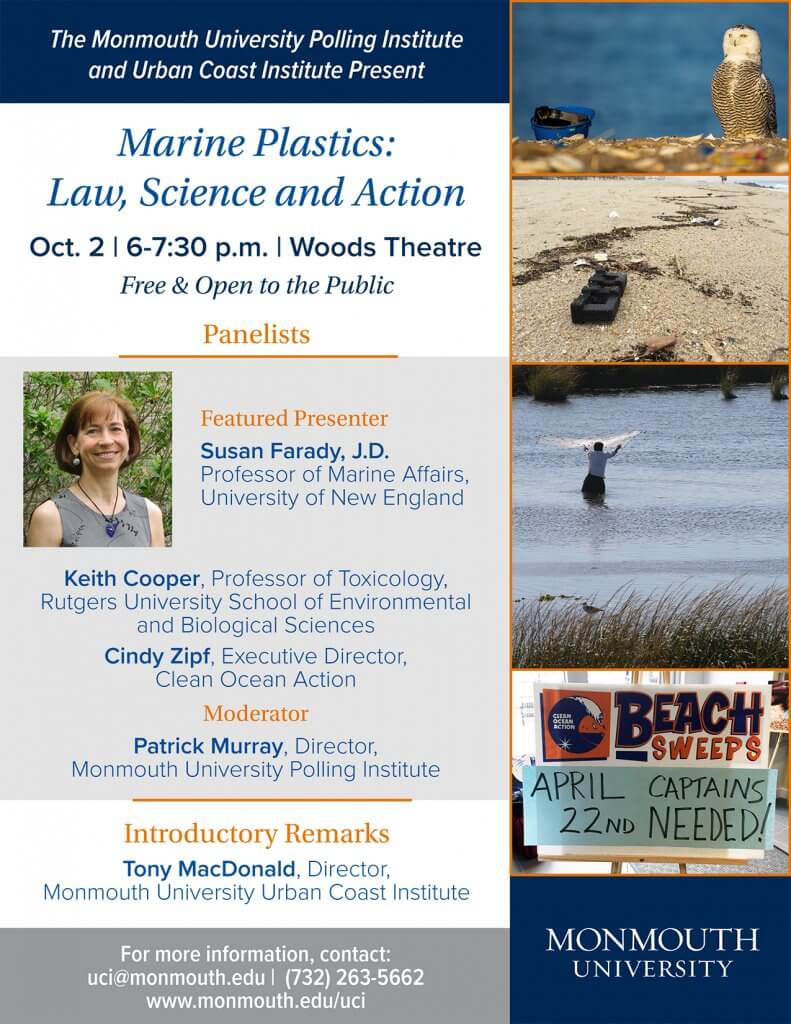
Monmouth U. and Rumson to Host Two River Seminar Series Sept. 26, Oct. 24
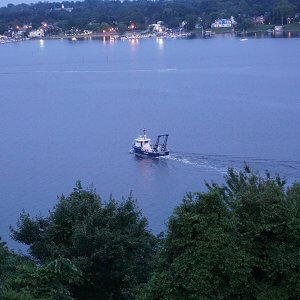 The Monmouth University School of Science and the Borough of Rumson will host a Two River Seminar Series centered on the environment and wildlife of the Navesink and Shrewsbury rivers beginning Thursday night. Members of the public of all ages are invited to participate in these educational discussions led by experts from the university’s Marine and Environmental Biology and Policy Program and Urban Coast Institute.
The Monmouth University School of Science and the Borough of Rumson will host a Two River Seminar Series centered on the environment and wildlife of the Navesink and Shrewsbury rivers beginning Thursday night. Members of the public of all ages are invited to participate in these educational discussions led by experts from the university’s Marine and Environmental Biology and Policy Program and Urban Coast Institute.
The series kicks off this Thursday, Sept. 26, at 7 p.m. with “Our Watershed as a Living Laboratory.” The session will cover historic and emerging scientific questions surrounding the rivers, current research efforts focused on the watershed’s health and steps needed to make it more resilient to climate change.
On Oct. 24 at 7 p.m., the series continues with “Rivers Alive: Wildlife and Habitats of the Two River System.” This seminar will explore the area’s unique plant life, wetlands, fish, reptiles and amphibians.
The events will be held at Bingham Hall, located at 40 Bingham Ave. in Rumson. There is no cost to attend.
The Two River Seminar Series is part of a broader educational collaboration between Rumson and Monmouth. Plans are underway to develop a Monmouth Marine and Environmental Field Station on municipal property located behind Borough Hall on the Navesink River. With an array of classrooms, laboratories and meeting spaces, the field station will provide a waterfront location for educational programs and facilitate research opportunities for Monmouth University students, alongside K-12 students from the Rumson School District and surrounding communities.
For more information, contact Karl Vilacoba at kvilacob@monmouth.edu or (732) 571-3688.
Exhibition Explores Economic and Emotional Toll of Superstorm Sandy through Art, Multimedia
Nearing Anniversary of Sandy, Residents Invited to Post their Stories to Gallery Wall
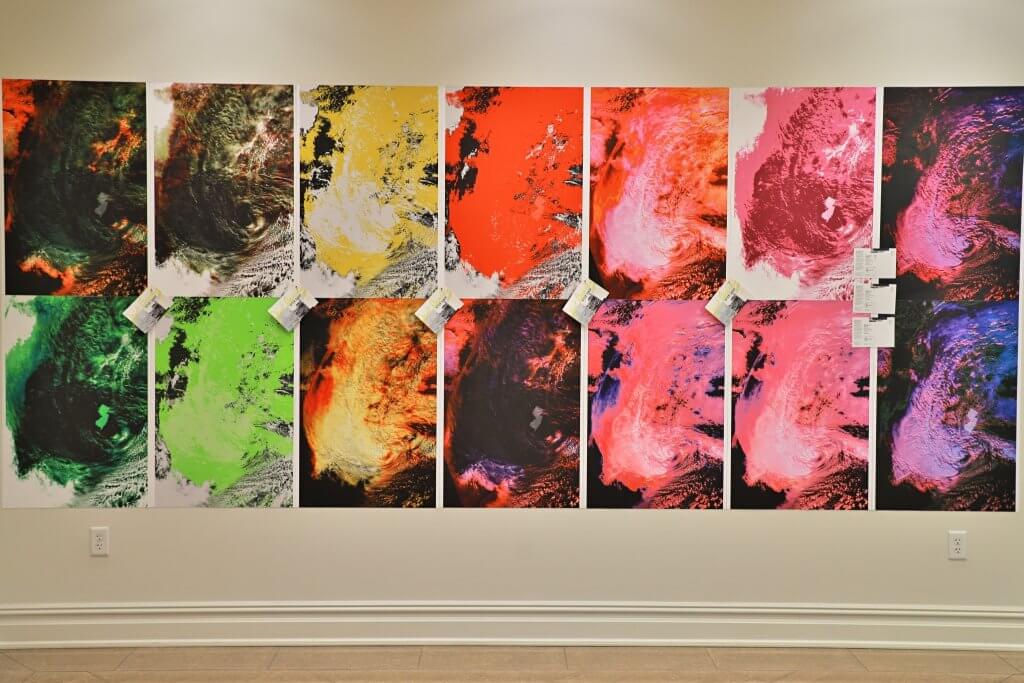
With the seventh anniversary of Superstorm Sandy approaching, a new exhibition at Monmouth University captures the destructive force of the storm and the mounting threats of climate change and sea level rise through abstract and participatory works of art. Free and open to the public, the exhibition encourages residents who were impacted by Sandy to contribute to the installation by sharing their memories on a special wall adorned with satellite imagery of the storm.
 “Just Beachy/After Sandy,” featuring the work of Monmouth University Department of Art and Design Professor Karen Bright and Assistant Professor of Communication Amanda Stojanov, can be viewed at the DiMattio Gallery, located in Rechnitz Hall. Some of the exhibition’s highlights include:
“Just Beachy/After Sandy,” featuring the work of Monmouth University Department of Art and Design Professor Karen Bright and Assistant Professor of Communication Amanda Stojanov, can be viewed at the DiMattio Gallery, located in Rechnitz Hall. Some of the exhibition’s highlights include:
- The Drying Station: Nearly a century of scientific data for natural phenomena such as high tide levels, wave heights and wind speeds on the Jersey Shore are interpreted by Bright in the form of beach towel designs. The towel panels hang in an arrangement that allows visitors to walk among and between them.
- 9 Feet High: Those who endured Sandy can “erase” the storm by covering up this wall of NASA satellite images with their hand-written stories. The colorful prints were designed by Bright with production assistance by Stojanov.
- The Climate Shelter: Visitors can step into a personal-sized, geodesic-domed shelter to hear and view a digital media interpretation, “Hurricane,” created by Stojanov. The outside is decorated with prints and paintings by Bright – representing a world turned inside out – requiring a new way of thinking about climate and the effects of global warming.
- The Transformer: At over 10 feet high, this information graphic in the form of a sculpture visualizes the massive number of housing units that were lost in New Jersey and New York as a result of Sandy. Bright’s sculpture is composed of stacked tree rounds topped by two bird houses fashioned to look like green Monopoly game houses, which are sized to mathematically represent the number of lost homes. A sandbox at its base offers visitors a chance to rake or bury a small relic from their Sandy experience, or just provide a moment of release.
“The driving intent for ‘Just Beachy/After Sandy’ is to reach out to people through action,” Bright said. “The installation offers visitors the chance to share their personal stories and release them to the wall, contemplate while raking or digging sand, hear and view a media interpretation of Sandy while sitting in a quite space, and learn while walking through a maze of hanging panels. The hope is that by bringing the community together, people will find personal relief through shared experience.”
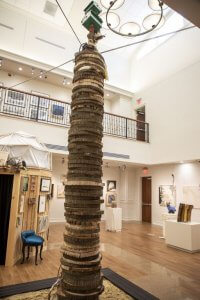 Two complementary exhibitions led by Bright are also now open for viewing. “Karen Bright―Throughline,” also at the DiMattio Gallery, features four decades of the artist’s works centered on the environment as well as prevalent social and cultural issues such as the #MeToo movement and politics. ”A Sense of Place in Contemporary Encaustic,” at the neighboring Ice House Gallery, features 24 artists’ works that provide interpretations of space, ranging from serene landscapes to the abstract.
Two complementary exhibitions led by Bright are also now open for viewing. “Karen Bright―Throughline,” also at the DiMattio Gallery, features four decades of the artist’s works centered on the environment as well as prevalent social and cultural issues such as the #MeToo movement and politics. ”A Sense of Place in Contemporary Encaustic,” at the neighboring Ice House Gallery, features 24 artists’ works that provide interpretations of space, ranging from serene landscapes to the abstract.
The exhibitions are open for public viewing during standard gallery hours of 10 a.m. to 5 p.m. Monday-Friday and 10 a.m. to 4 p.m. on weekends.
The exhibitions are also part of the Monmouth University Center for the Arts 2019-2020 season. “Just Beachy/After Sandy” was funded in part by the Monmouth University Urban Coast Institute. For more information, visit www.monmouth.edu/mca.
‘Climate Change and the Voiceless’ Endowed Chairs Lecture 9/26 at 1:30 p.m.
Rechnitz Family/UCI Endowed Chair in Marine and Environmental Law and Policy Randy Abate will discuss his upcoming book on the legal treatment of “voiceless” victims of climate change on Thursday, Sept. 26, at Monmouth University’s Pozycki Hall Auditorium. The event is free and open to the public. View directions to campus and the venue.
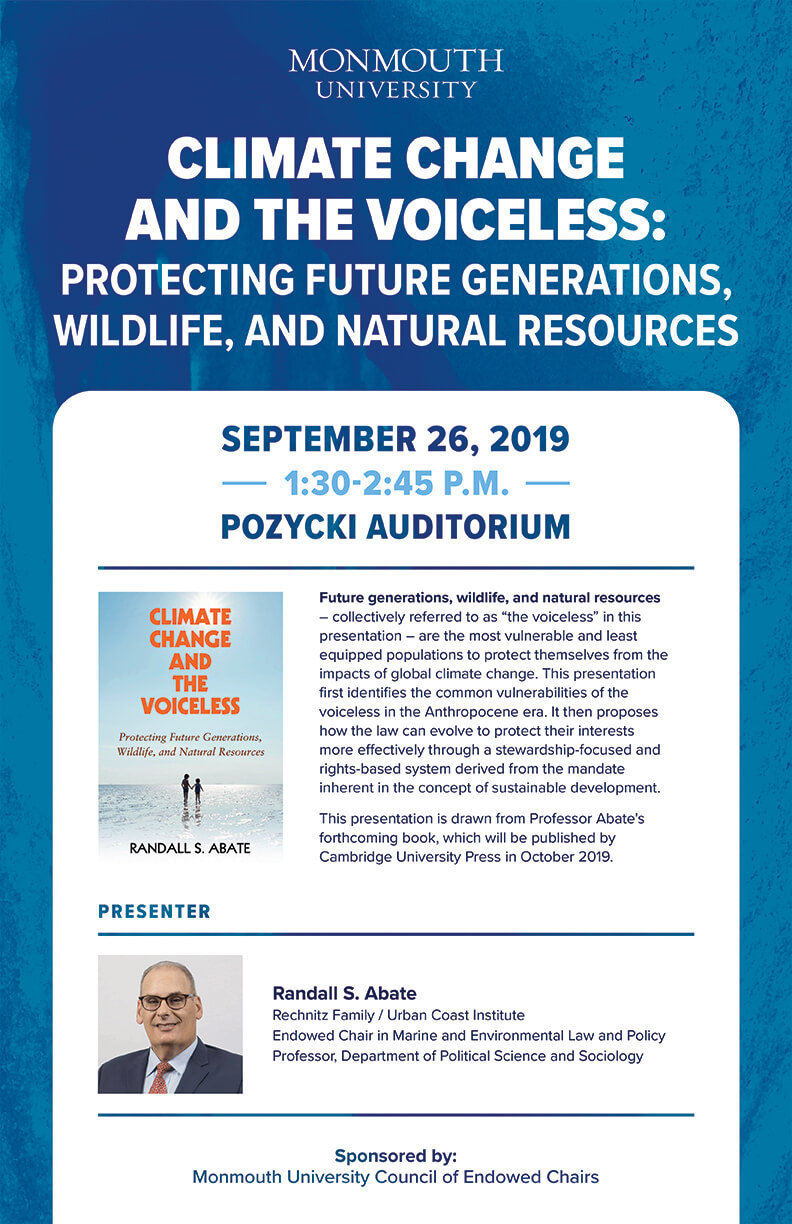
New Jersey Has Been Lucky (So Far) with its Freshwater Algal Blooms. It Probably Won’t Last.
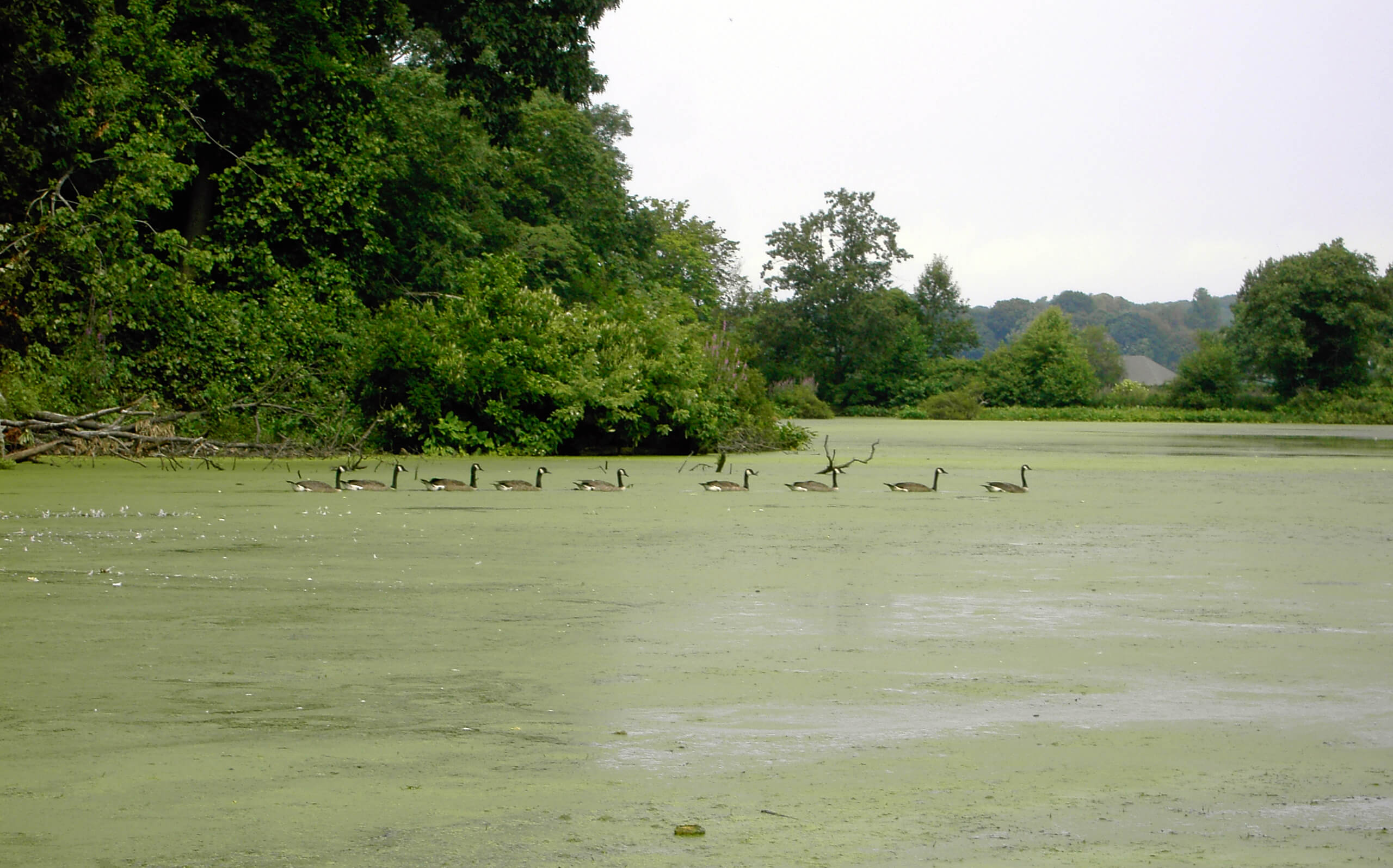
By Jason E. Adolf, PhD
Environmentalists from around the state have rightly voiced their alarm over the spike in harmful algal blooms (HAB) that have plagued freshwater bodies like Lake Hopatcong and Greenwood Lake since this summer and called for more aggressive watershed management-based solutions. My 22 years of experience as a scientist working with HABs has given me a perspective on the urgency of what is happening and why solutions need to be enacted now. New Jersey is actually lucky right at the moment ― cyanotoxin levels remain low even though the lakes are filled with high levels of HAB organisms. However, research into the factors that amplify toxin levels in blooms like these suggests that it is only a matter of time before our luck runs out.
The expansion of freshwater cyanobacteria (often called blue-green algae) blooms has been noted for years among researchers. While many recent media reports have focused on the link between nutrients, climate and HAB formation, none have clearly articulated the threat posed by the potent toxins these HABs can produce if and when they start to produce them in excess. The latest measurements by the New Jersey Department of Environmental Protection (NJDEP) show that HABs are occurring without high toxin levels. However, this can change and it is worth noting that the public health crisis presented by a lake full of toxin-producing HABs is far greater than what we are currently seeing, as evidenced by the highly toxic HABs that occurred in Florida’s Lake Okeechobee in the summer of 2018.
The microorganisms that cause these HABs can, under certain conditions, start producing high levels of potent toxins. Think of the HABs as collections of cells – not just different species but also different “strains,” or genetic variants, of the same species. Some strains make cyanotoxins, and others don’t.
For instance, the species Microcytis can produce the toxin microcystin. A lake full of the species Microcystis will include some strains that do not make cyanotoxin and some strains that do. Of course, bigger blooms potentially make more cyanotoxin, but an increase in the ratio of toxic to non-toxic strains can also change overall toxicity. When a lake is dominated by non-toxic strains of Microcystis, then overall cyanotoxin levels (microcystin) are low. When toxic strains dominate, then overall cyanotoxin levels are high.
To date, according to the Sept. 18 NJDEP Lake Hopatcong sampling update, cyanotoxin levels remain below the 3 parts per billion (ppb) New Jersey health advisory level, even though cyanobacterial cell levels are high. By comparison, microcystin cyanotoxin levels in the 2018 Florida blooms exceeded 100 ppb and many people were hospitalized following contact.
Thus, the attention and crisis surrounding New Jersey’s 2019 lake HABs, while very much warranted, is due to the presence of cells without significant levels of cyanotoxin present. What if we had to deal with high cell and cyanotoxin levels in places like Lake Hopatcong and Spruce Run Reservoir?
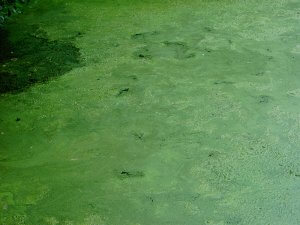 What turns a less-toxic HAB into a highly toxic HAB? A few highlights from contemporary research conclude that excess nitrogen loading (even in the face of phosphorus controls) appears to favor toxic strains over non-toxic strains of Microcystis. Other experiments in North American lakes found that elevated water temperature, in combination with elevated nutrients, favors accumulation of toxic Microcystis strains over non-toxic strains. Elevated temperature and CO2 levels are likely to favor accumulations of cyanobacteria in lakes over other types of algae. This area of research is continuing and needs investment in New Jersey because understanding the specific conditions that turn our HABs into highly toxic events will inform management and predictive modelling of these events. This research, along with informed citizens anxious to play a role in the science associated with monitoring and prediction, will help us get ahead of this problem instead of repeatedly reacting to events after they occur ”out of nowhere.”
What turns a less-toxic HAB into a highly toxic HAB? A few highlights from contemporary research conclude that excess nitrogen loading (even in the face of phosphorus controls) appears to favor toxic strains over non-toxic strains of Microcystis. Other experiments in North American lakes found that elevated water temperature, in combination with elevated nutrients, favors accumulation of toxic Microcystis strains over non-toxic strains. Elevated temperature and CO2 levels are likely to favor accumulations of cyanobacteria in lakes over other types of algae. This area of research is continuing and needs investment in New Jersey because understanding the specific conditions that turn our HABs into highly toxic events will inform management and predictive modelling of these events. This research, along with informed citizens anxious to play a role in the science associated with monitoring and prediction, will help us get ahead of this problem instead of repeatedly reacting to events after they occur ”out of nowhere.”
The impacts of humans, including excess nutrient loading to lakes, elevated CO2 levels and rising water temperatures due to climate change, will not only ensure the re-occurrence of these blooms but stack the odds in favor of them becoming toxic and a far more menacing public health threat than what we currently see in New Jersey. Research into these linkages must play an important role in directing actions for solutions.
Jason Adolf is an endowed associate professor of marine science with Monmouth University’s Biology Department and Urban Coast Institute. He runs the Phytoplankton and Harmful Algal Bloom research lab (PHABLab) at Monmouth University, where undergraduate students learn phytoplankton research including HABs in various New Jersey environments. Instagram: monmouth_phab_lab.
Watch: Students Discuss Summer Science Research Projects
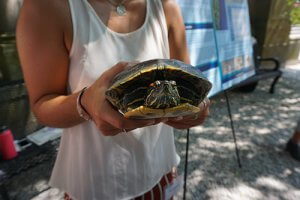 Over three dozen student projects were on display at the Monmouth University School of Science’s 2019 Summer Research Program Symposium, held Aug. 8 at the University’s Erlanger Gardens. The poster session has become an annual tradition, providing students an opportunity to share the work they completed over the preceding 12 weeks with friends, family, faculty members and the public.
Over three dozen student projects were on display at the Monmouth University School of Science’s 2019 Summer Research Program Symposium, held Aug. 8 at the University’s Erlanger Gardens. The poster session has become an annual tradition, providing students an opportunity to share the work they completed over the preceding 12 weeks with friends, family, faculty members and the public.
The UCI supports several summer research projects each year through its UCI Scholars Program. Scroll down to hear some of the students discuss their work. Abstracts for all of the research projects presented at the symposium can be found here.
Turtles of Lake Takanassee: How Does this Assemblage Persist?
Christiana Popo and Travis Kirk
Characterizing Deoxygenation and Harmful Algal Blooms in Branchport Creek, New Jersey
Skyler Post and Erin Conlon
Can Rainfall Predict Fecal Indicator Bacteria Levels at Monmouth County Surfing Beaches Near Stormwater Outfalls?
Kelly Hanna and Victoria Lohnes
Nutrient Pollution and Harmful Algal Blooms Take a Toll on Monmouth County Coastal Lakes
Ariel Zavala
Using Environmental DNA (eDNA) to Track Black Sea Bass and Winter Flounder in a Controlled Tank Environment
Karolina Szenkiel
The UCI Scholars Program is supported through the generosity of private and corporate donors. If you would like to make a tax-deductible gift to the Urban Coast Institute, please use our Give a Gift Now contribution form.
UCI and Monmouth Students Pitch in to Restore Barnegat Bay Oysters
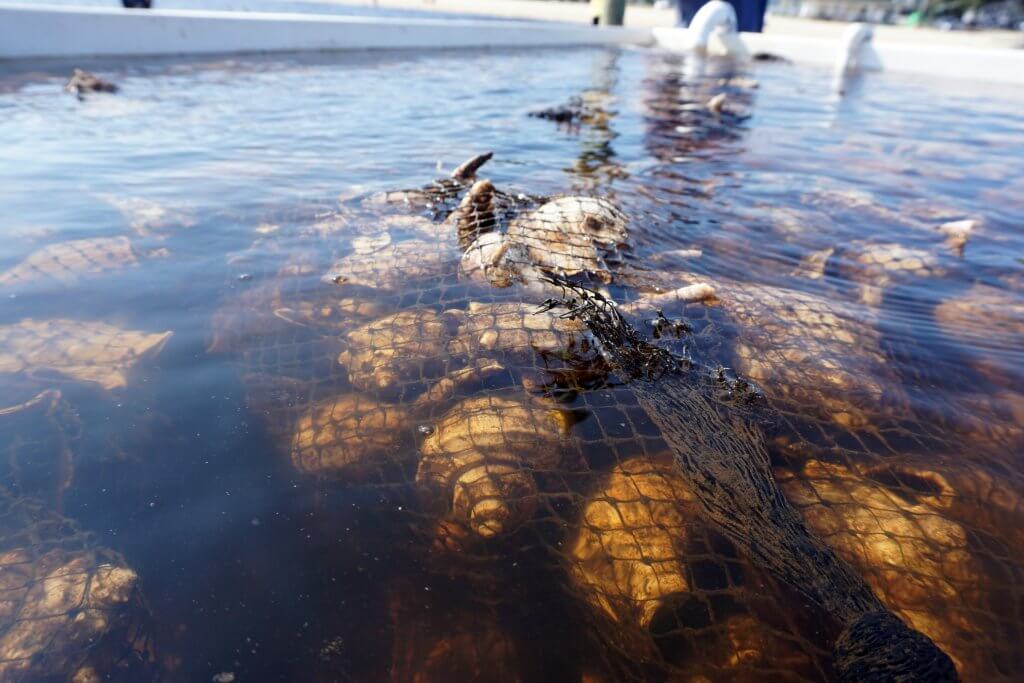
You can throw these babies out with their bath water. At the end of the Wildwood Avenue Pier in Ocean Gate sat a tank full of young oysters (called “spat”) clinging to recycled shells donated by restaurants. A crowd of volunteers would soon escort them to a more spacious new home – an artificial reef a few hundred yards off Good Luck Point in the Barnegat Bay.
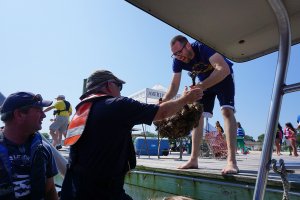 The American Littoral Society’s (ALS) July 25 Parade of Boats was the culmination of a season-long effort to raise oysters in a nursery before placing them in the wild. The Urban Coast Institute (UCI) has participated in the event each summer since its inception in 2015. In the first year, UCI Marine Scientist Nickels mapped the zone where the reef now sits using a remote operating underwater vehicle (ROV) and side-scan SONAR in an effort to identify an area where the oysters stood the best chance of survival.
The American Littoral Society’s (ALS) July 25 Parade of Boats was the culmination of a season-long effort to raise oysters in a nursery before placing them in the wild. The Urban Coast Institute (UCI) has participated in the event each summer since its inception in 2015. In the first year, UCI Marine Scientist Nickels mapped the zone where the reef now sits using a remote operating underwater vehicle (ROV) and side-scan SONAR in an effort to identify an area where the oysters stood the best chance of survival.
After several summers of depositing the shells at the site, ALS Habitat Restoration Program Director Capt. Al Modjeski said the organization’s testing indicates the oysters are thriving there on their own. He estimated that around 200,000 now populate the reef zone.
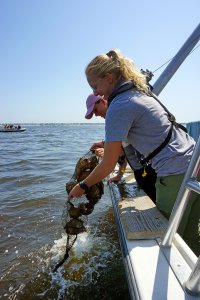 Nickels, Monmouth University students Lauren Kelly and Hannah Craft and other volunteers on the scene loaded Monmouth’s R/V Seahawk with sacks full of shells and dumped them overboard at the reef. According to Modjeski, the baby oysters have about a 10% survival rate.
Nickels, Monmouth University students Lauren Kelly and Hannah Craft and other volunteers on the scene loaded Monmouth’s R/V Seahawk with sacks full of shells and dumped them overboard at the reef. According to Modjeski, the baby oysters have about a 10% survival rate.
The goal of the reef project is to help wild oyster populations rebound in the bay, where they can make important impacts for both the economy and the ecosystem. Oysters are a natural water purification system, with one adult capable of filtering up to 50 gallons of water in 24 hours. They can also create habitats for marine organisms, stabilize the grounds around them and blunt the force of wave action during storms.
See our post on Facebook for more photos from the event. For more information on the program, visit the American Littoral Society blog.
Ocean Inspires Student Poster Designs
By Hanan Al Asadi, UCI Communications Assistant
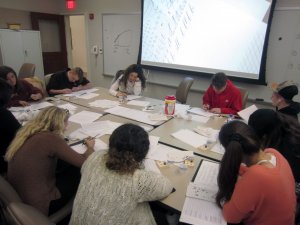 Students in Associate Professor Jing Zhou’s Digital Illustration course recently designed a series of posters promoting real and fictitious events about the ocean and coastal ecosystems. With the support of a UCI mini-grant, Zhou purchased calligraphy tools and supplies and coached the students to incorporate calligraphical elements into their work. Zhou believes the project provided a valuable design lesson and contribution to the course.
Students in Associate Professor Jing Zhou’s Digital Illustration course recently designed a series of posters promoting real and fictitious events about the ocean and coastal ecosystems. With the support of a UCI mini-grant, Zhou purchased calligraphy tools and supplies and coached the students to incorporate calligraphical elements into their work. Zhou believes the project provided a valuable design lesson and contribution to the course.
Zhou said her inspiration for the project stemmed from a realization that many of today’s students struggle with performing handwriting illustrations in our modern age of technology. She feels that it is highly important for students to have an artistic appreciation for calligraphy and not to lose their handwriting abilities as the result of a reliance on digital tools.
“From a personal perspective, calligraphy is the aesthetic manifestation of languages and cultures created by hand,” she said.
When Zhou surveyed her students, the majority declared that they hadn’t been exposed to the art of calligraphy.
“It is sad for me to observe new generations who have lost the opportunity to practice writing by hand and, not to mention, the joy and satisfaction of creating tangible work, which is irreplaceable by digitally assisted productions,” Zhou said.
The students’ final posters were created using Adobe Illustrator. Scroll below to view samples of their work.
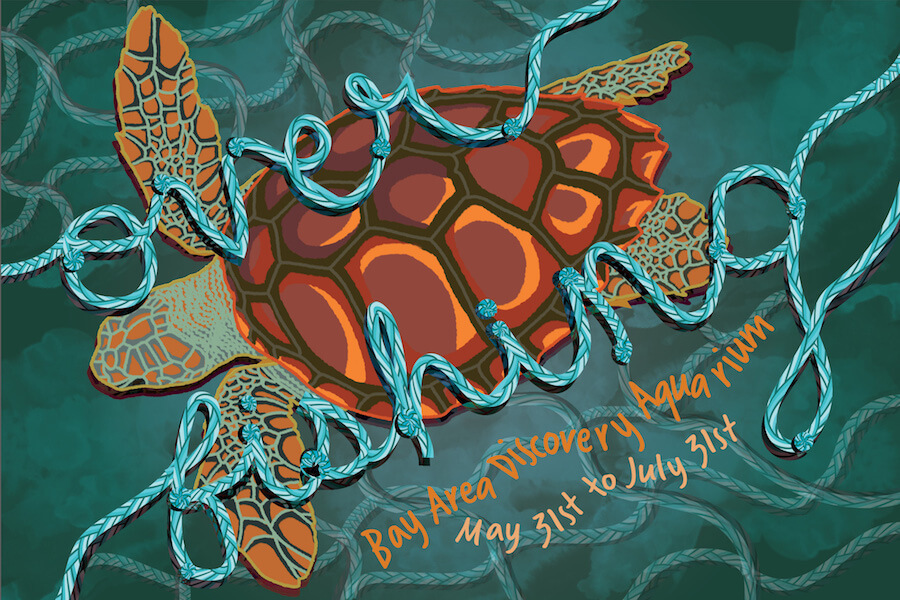
“Overfishing” by Lauren Haug
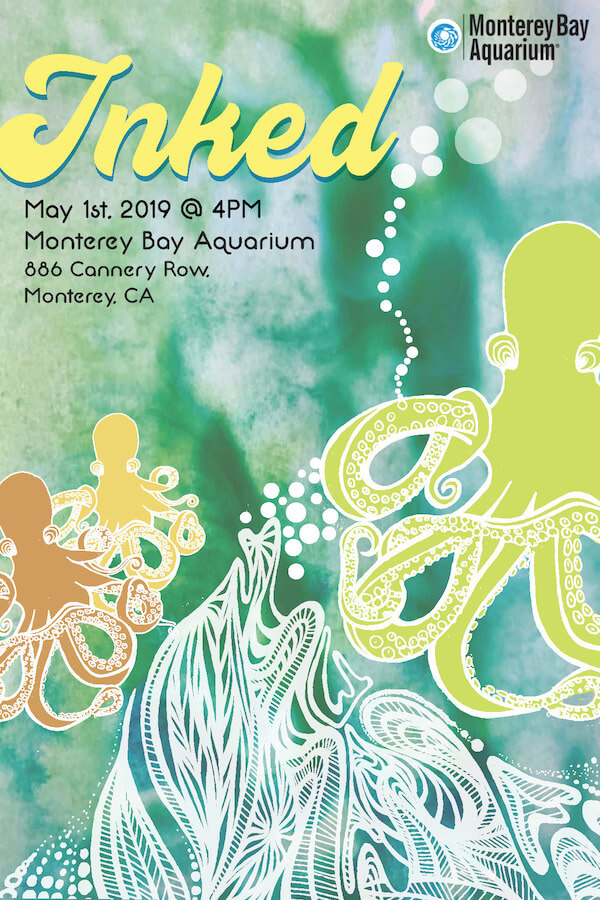
“Inked” by Jill Martin
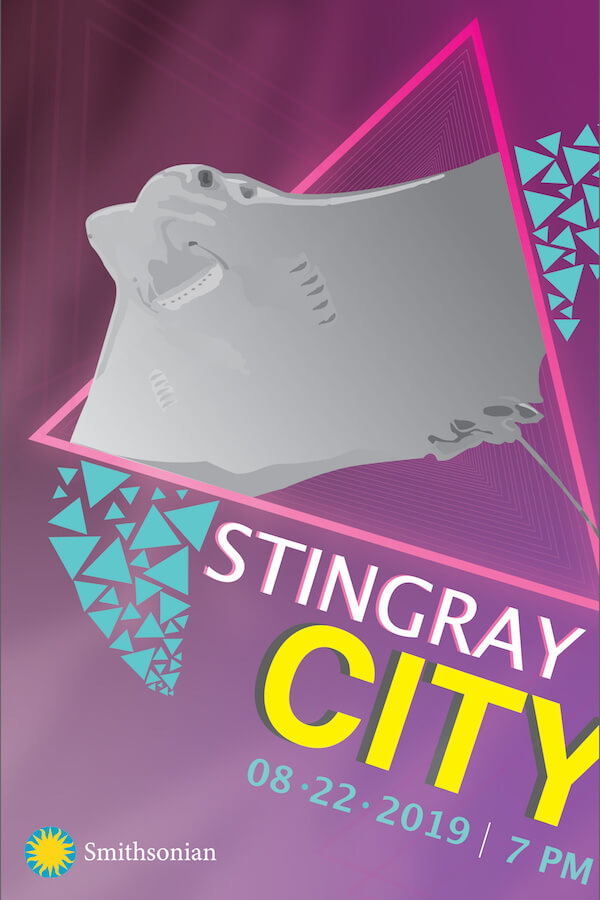
“Stingray City” by Laura Kassin
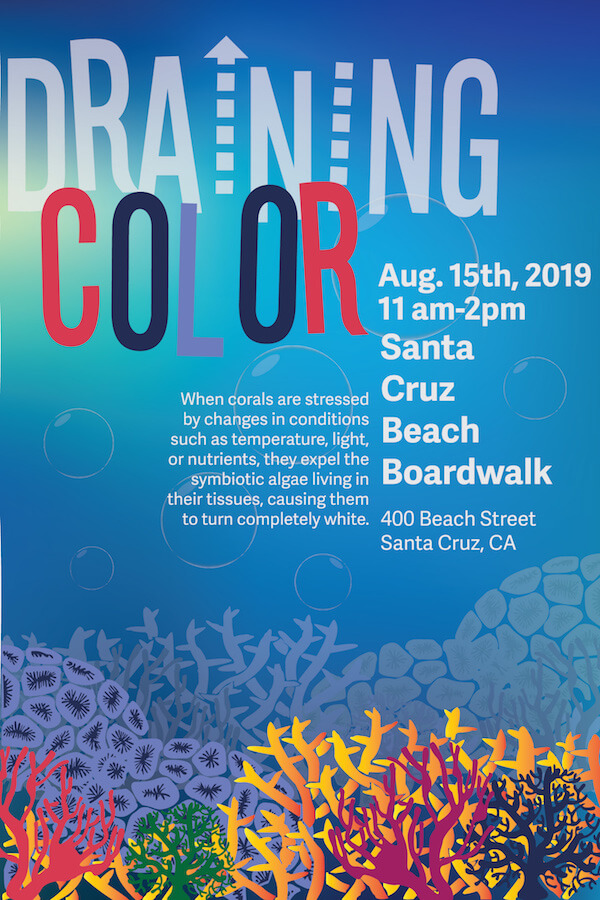
“Draining Color” by Jenna Capitelli
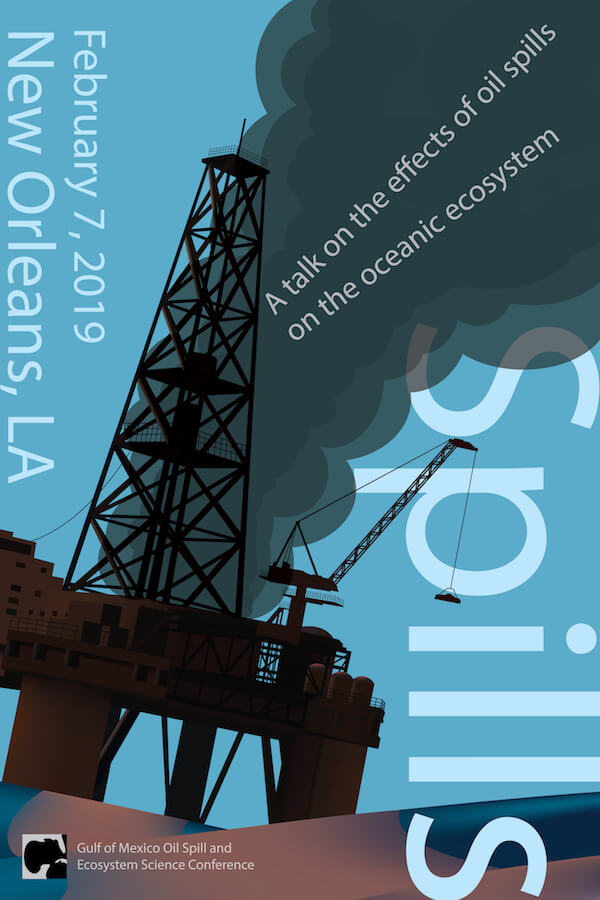
“Spills” by Noah Rottler-Gurley
‘This Is Jersey’ Focuses on Monmouth Efforts to Monitor Water Quality in Local Lakes, Beaches
Verizon FiOS 1’s “This Is Jersey with Gary Gellman” recently visited Monmouth University for this interview with Jason Adolf, endowed associate professor of marine science. The segment highlights work by Adolf and his students to monitor water quality at coastal lakes and beaches, study how the closure of Oyster Creek nuclear plant has impacted the ecosystem, sample local waters for marine environmental DNA (eDNA), and much more.
Paid Student Positions Available for Climate Risk Research
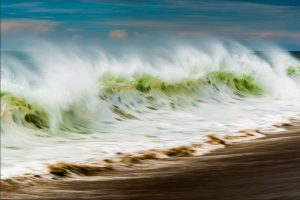 Monmouth University students can apply for a number of paid positions conducting door-to-door surveys for select coastal towns in the Raritan Bay area and Monmouth County through the Institute for Sustainable Cities (ISC) at Hunter College and Consortium for Climate Risk in the Urban Northeast (CCRUN). The surveys will pertain to community and household coastal adaptation to sea-level rise, coastal storms, and nuisance flooding along with local development trends. The survey aims to determine how the perception of future sea level rise is influencing coastal homeowners’ decision-making and gauge their needs for further information pertaining to flood mitigation, including what local and state municipalities can do to propagate and assist local resiliency efforts. The desired outcome is to figure out the decision frames that households are using to address questions of increasing climate risk along with their risk tolerance to differing levels of flooding and what metrics they use to measure risk.
Monmouth University students can apply for a number of paid positions conducting door-to-door surveys for select coastal towns in the Raritan Bay area and Monmouth County through the Institute for Sustainable Cities (ISC) at Hunter College and Consortium for Climate Risk in the Urban Northeast (CCRUN). The surveys will pertain to community and household coastal adaptation to sea-level rise, coastal storms, and nuisance flooding along with local development trends. The survey aims to determine how the perception of future sea level rise is influencing coastal homeowners’ decision-making and gauge their needs for further information pertaining to flood mitigation, including what local and state municipalities can do to propagate and assist local resiliency efforts. The desired outcome is to figure out the decision frames that households are using to address questions of increasing climate risk along with their risk tolerance to differing levels of flooding and what metrics they use to measure risk.
Applicants must be currently enrolled at Monmouth University. Familiarity with survey methods and techniques would be beneficial but not necessary. A valid drivers license and access to a vehicle also would be beneficial. To apply, email a résumé to UCI Associate Director Tom Herrington at therring@monmouth.edu.
